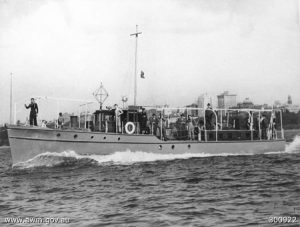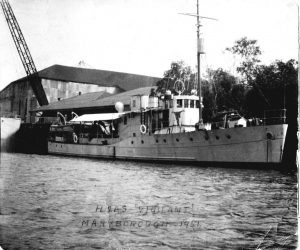- Author
- A.N. Other
- Subjects
- RAN operations, Ship histories and stories, WWII operations, History - WW2
- Tags
-
- RAN Ships
- HMAS Armidale I, HMAS Kuru, HMAS Vigilant, HMAS Voyager I, HMAS Hawk, HMAS Sleuth
- Publication
- September 2013 edition of the Naval Historical Review (all rights reserved)
The Patrol Vessel Vigilant was a prototype built by Cockatoo Island Dockyard. She was a handsome vessel and the first ship in Australia built with an aluminium hull and superstructure; as a result for her length, she had a light displacement. She was built for the Department of Trade and Customs and intended for use patrolling waters to the north of Australia.
The smaller Kuru was a wooden hulled boat built in Balmain for the Northern Territory Patrol Service, mainly intended to examine the catch of Japanese luggers to ensure they did not poach pearl shell.
Both were requisitioned by the RAN as auxiliary patrol vessels in late 1940. Initially Vigilant was based at Townsville but in 1941 both vessels were at Darwin. During the fateful Japanese air attacks Vigilant attempted to repulse these with her limited armament. She was lucky to escape serious damage, being close to the ammunition ship MV Neptuna when she was hit and exploded. Vigilant was involved in the rescue of survivors from the harbour.
HMAS Kuru
Sparrow Force, which had been sent to assist in the defence of Timor, had been reduced in fighting against the Japanese. In early 1942 it comprised a few hundred Australian and Dutch troops together with some Portuguese civilians who were carrying out a guerrilla campaign. They were in need of support but without the necessary fast vessels to transit these enemy controlled waters, so Kuru was dispatched in May 1942 to make contact with the Allied forces. Her mission was successful and in all she made six voyages to Timor, mostly under the command of LT Asher Joel, RANVR (to gain later fame as Sir Asher Joel). On her last mission Kuru was sent in company with the minesweepers HMA Ships Armidale and Castlemaine. Kuru arrived on 30 November and after unloading supplies began ferrying more than 70 women and children who were to be taken off. The minesweepers were delayed when they had to contend with enemy air attacks. Later Kuru rendezvoused with Castlemaine and transferred her passengers, who were to make the safety of Australian soil. Armidale and Kuru were spotted by Japanese aircraft where Armidale was sunk with heavy loss of life. Kuru was a much smaller target and with constant manoeuvrers over several hours of repeated heavy attacks by numerous aircraft suffered only minor damage with three men wounded. At last with the haven of nightfall she reached home safely. Her next notable feat was in January 1943 in rescuing survivors from HMAS Patricia Cam which had been sunk following an air attack.

Regrettably during a severe storm in October 1943, she sank alongside the floating dock in Darwin. The damage was so great she was withdrawn from service. In 1945 she was driven ashore in another storm, this time to be salvaged as a beachside home of a local hermit.
HMAS Vigilant
In July 1942 Vigilant, with a large hold capacity of 7 tons, also played an important part in the Battle of Timor providing essential supplies to Australian forces. Under the command of LEUT H.A. Bennett, RANR, sailing from Darwin she made three successful voyages and although attacked by Japanese aircraft she escaped unscathed. During this time she was involved in the search for survivors from Armidale and also resupplied other minesweepers operating in the Timor Sea, notably HMAS Deloraine when she provided her with depth charges during her successful engagement against a Japanese submarine.

On 22 September 1942 the destroyer HMAS Voyager was dispatched from Darwin with 250 men of the 2/4th Independent Company and a considerable amount of supplies to reinforce the Allies in Timor. Because of his local knowledge LEUT Bennett, the commanding officer of Vigilant and a previous CO of Kuru, was lent to Voyager to assist with navigation. The next day Voyager made her destination in the uncharted Betano Bay and began troop disembarkation. Disaster struck when she dragged her anchor in strong tidal waters and became stranded on the beach with all efforts to free her failing. When spotted by enemy aircraft she was an easy target and to avoid falling into enemy hands the unenviable decision was taken to scuttle the ship. HMA Ships Kalgoorlie and Warrnambool later carried out a rescue mission to return survivors to Darwin.
Man of many commands
LT Herbert Alan Bennett, RANR is a wartime mystery. Initially appointed a Probationary Temporary SBLT RANR (S) in 1941 at the age of 42, he held a Second Mates (Foreign Going Certificate) which suggests he had left the sea many years before and was now living and working ashore in Fremantle. Could he have been a tug master? He possibly had more commands than any other officer in the RAN, including HMA Ships Winnilya, Larrakia, Kuru, Gunbar, Vigilant, Tooronga (not commissioned), Sprightly, Warrnambool and Ballarat. Parts of his service records are very faded but on taking command of Ballarat he was promoted LCDR RANR in February 1946. He apparently left the RAN shortly afterwards, not appearing in the October 1946 Navy List.
The final curtain
As the war moved north the smaller patrol craft had less to do and on 17 April 1944 Vigilant was renamed HMAS Sleuth and again renamed on 13 March 1945 as HMAS Hawk. She was decommissioned on 12 November 1945, five years to the day from her original commissioning. She was then returned to Trade and Customs once more as PV Vigilant. This was not to last long and she was sold to commercial interests and involved in whale spotting of the West Australian coast until this trade declined in 1965. She then returned to Sydney where it was hoped she would be restored but in a pay dispute in April 1966 she was sunk by her crew while alongside at her moorings in Sydney. The hulk was later broken up and so ignominiously ended the career of one of our finest small vessels.
The end of the gallant HMAS Kuru, which alone had defied the might of the Japanese air force, was tragic. In October 1943 she was caught in a severe storm and accidentally driven into the side of Darwin’s floating dock. The damage was so great she was withdrawn from service. In 1945 she was driven ashore in another storm, this time to be salvaged as a beachside home of a local hermit.
HMA Ships Kuru and Vigilant were small well built vessels not designed or destined for war and, of which not too much could be expected in their new roles. However with dedicated officers and men they punched way above their weight and played their part in the Battle of the Timor Sea with determination and distinction.
Kuru Vigilant
Builders Balmain Cockatoo Island Dockyard
Launched 1938 12 February 1938
Displacement 55 tons ? 106 tons
Length 76 ft 102 ft
Engines 1 x 320 hp diesel ? 2 x 16 cyl 320 hp diesel
Service Speed 9 knots ? 14.7 knots
Complement 21 men 15 men
Armament 1 x 20 mm Oerlikon + LMGs 1 x 20 mm Oerlikon + LMGs
+ Depth Charges




